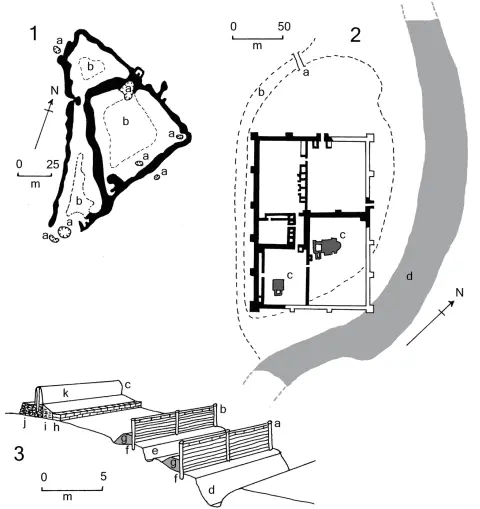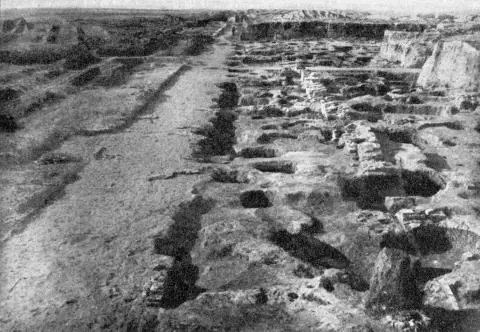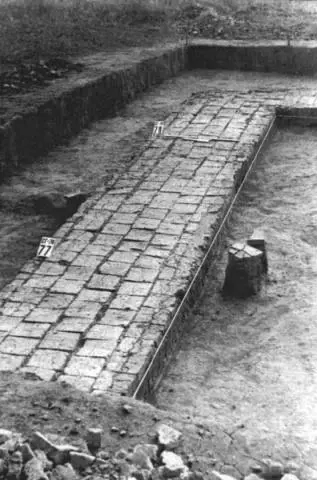Various written sources mention the 7th–8th century Khazars’ habit of assembling their wagons into a defensive circle, strengthened by the addition of shields, even during pauses on the march. By the 7th century, however, they also began using more permanent fortifications in particularly threatened regions, the earliest known examples being found in Chir-Yurt, Andrewaul and elsewhere in Daghestan. Nevertheless, the question of whether nomadic Khazars themselves actually built these fortifications remains controversial, as the structures might more plausibly be credited to the local settled populations.
Classification
The north-western border of the Khaganate was a dangerously exposed region, where about 40 fortified locations dating from Khazar times have been found in the Don and Seversky Donets river basins. These can be divided into the following types:
(1) Fortifications of the immediate pre-Khazar period (pre-7th century), whose defensive works were almost never rebuilt.
(2) Fortifications located on narrow coastal promontories, and protected only on the landward side. In the construction of such sites natural features of terrain were maximized; slopes were steepened, and two or three lines of defences added. They vary in the presence or absence of additional defences along the water perimeters of the promontory.
(3) Fortifications constructed of stone or brick with clearly defined geometric plans, usually roughly rectangular, and sometimes with towers. These show a considerable advance over the earlier examples in both architectural and defensive capabilities. They could also sustain a permanent or replaceable garrison◦– for example at Sarkel, where 300 individuals were reportedly rotated each year. The building of such a fortress is estimated to have required over 20,000 man-working days, so their construction can only have been a planned state action. Furthermore, the concentration of this type of fortress along the north-western border of Khazar territory highlights the fact that they were intended to face a powerful north-western enemy, which can only have been Kievan Russia.

Fortifications in the Khazar Khaganate.
(1) Defensive earthworks at Pravoberezhny, Tsimlyansky district, 8th–10th centuries: (a) pits; (b) internal raised areas.
(2) Fortress of Sarkel, AD 833–965, with trace of brick walls and towers shown black: (a) presumed site of entrance bridge; (b) ditch; (c) later internal buildings; (d) bed of River Don.
(3) Sectional reconstruction of defences in the northern sector of Verkhniy Saltov hill fort: (a) outer defences; (b) middle defences; (c) inner defences; (d) first ditch; (e) second ditch; (f) timber palisades; (g) earth platform; (h) brick outer shell; (i) inner shell; (j) rubble platform; (k) clay cladding over wooden framework. (Drawings by David Nicolle)
The evidence from Sarkel
Sarkel is an example of this third type. In 834–837, at the request of the Khagan’s government, Petron Kamatir and a team of Byzantine engineers built a fortress on the bank of the Don river, near present-day Tsimlyansk. Its name in the Ugrian tongue meant ‘White House’, while Russian chroniclers call it the ‘White Tower’. This fortification was initially intended as a defence against the migrating Magyars, and was both inhabited and garrisoned by Khazars and Bulgars.
The fortress of Sarkel was a regular rectangle measuring 193.5 x 133.5m (634.6ft x 437.8ft), oriented along a south-east to north-west axis. Its walls were made of red brick laid in a local manner, having a thickness of 3.75m (12.3ft) and an original height of no less than 10m (32.8ft). These walls were strengthened with protruding towers plus larger corner towers, and the main entrance was through a gate in a north-western tower. Internal walls also divided the fortress into several parts, and the smallest, south-eastern part had no external exits. This served as the main stronghold, within which, in the southern corner, stood a square main tower or donjon.
Despite the participation of Byzantine craftsmen, and having an essentially Byzantine plan, Sarkel fortress was built following local traditions. Substantial ramparts and moats separated the cape on which it was built from the main shore, but the walls and towers lacked true foundations, having been built directly onto levelled ground. For the bonding of walls a liquid lime solution was used with the addition of sand, and the bricks had actually been made and fired inside the walled areas, seemingly overseen by Byzantine craftsmen. The main internal walls separating the parts of the fortress were only slightly thinner than the external wall. Within the fortification there were large, long brick buildings whose floors were paved with either brick or a lime cement. According to the written sources, the Byzantine engineer Petron Kamatir had wanted to erect a stone church within the fortress but was not permitted to do so. Instead the stone columns and capitals that he had brought from Byzantine territory for this purpose were simply abandoned on the nearby steppe.

Reconstuction of the fortress at Sarkel. The viewpoint is looking south-westwards from the bank of the Don. (Drawing by David Nicolle)
By building Sarkel the Khazars not only protected themselves from Rus, but could now block the trade route between Kiev and Atil. In the event, Sarkel only served as a simple military fortress for one or two decades; thereafter settlers began to take over the site, and Sarkel rapidly became a centre for merchants and craftsmen, with a multi-ethnic population of Bulgars, Ghuzz, Khazars and others. Eventually almost the entire area between the river and the dry moat of the fortress itself was built up with yurt tents and semi-dugout houses. When there was no free space left the brick fortifications themselves began to be partially re-configured.

Excavations at Sarkel during the 1930s, showing bases of the fortified wall and towers. (Archive of M Zhirohov)
The evidence of ceramics and certain aspects of the habitations suggest that Bulgars inhabited the south-eastern part of Sarkel and Slavs the north-western corner, while the citadel was inhabited by Turks◦– Khazars and Ghuzz◦– who formed the garrison. In addition to guarding Sarkel and the important route on which it stood, they also collected dues from passing merchants using the river and the road north and south.

Excavations at the Khazar-period fortress at Semikarakorsk beside the lower Don River, showing the brick foundations of the north-eastern corner. (Archive of M Zhirohov)
Sarkel was taken by the Rus prince Svyatoslav in 965, and was badly damaged during his assault, but the location continued to be inhabited until the 12th century. By that time Sarkel had become a Russian steppe outpost known as Belaya Vezha or ‘White Vezhi’, and it was during this period that Russian colonization started to spread across the Don and Seversky Donets river areas.
Then, at the start of the 12th century, rising Kipchaq (Polovtsian) pressure on Kievan Rus made sustaining White Vezhi increasingly difficult. In 1103, while returning from a campaign against the Kipchaqs and intending to strengthen Russian influence in this region, Prince Vladimir Monomakh brought with him both Kipchaqs and Torks (another nomadic Turkish tribe) as settlers. Until 1117 they formed the garrison of Russian Belaya Vezha, but in that year the Kipchaqs and Torks turned against the Russians and forced most of the inhabitants of Sarkel-Belaya Vezha to flee to more secure Russia territory. Thereafter Kipchaq and Tork nomads roamed the region and raided Russia itself. Even so, a small number of Slav Rus remained in what had been Sarkel, and were later mentioned in Russian chronicles as ‘brodniki’.
Читать дальше
















